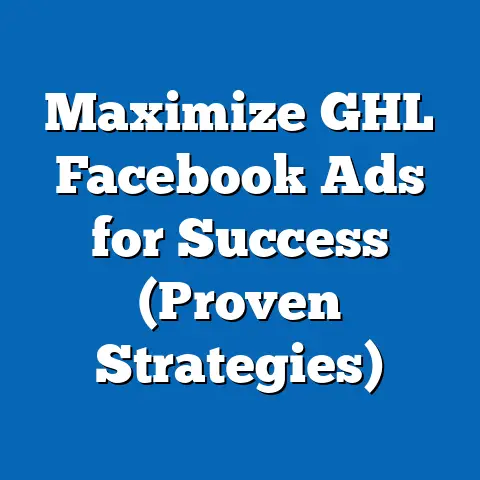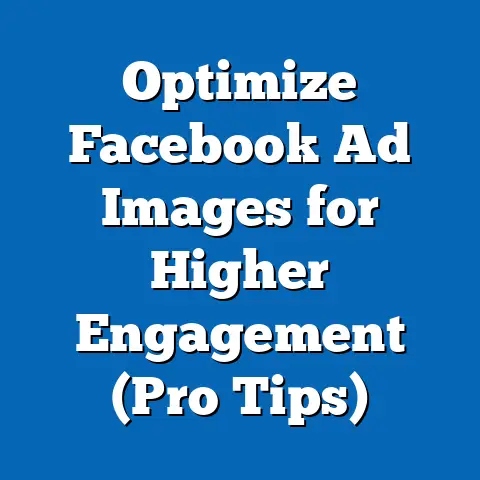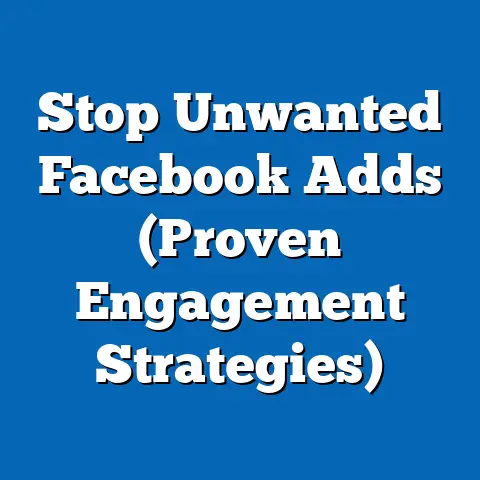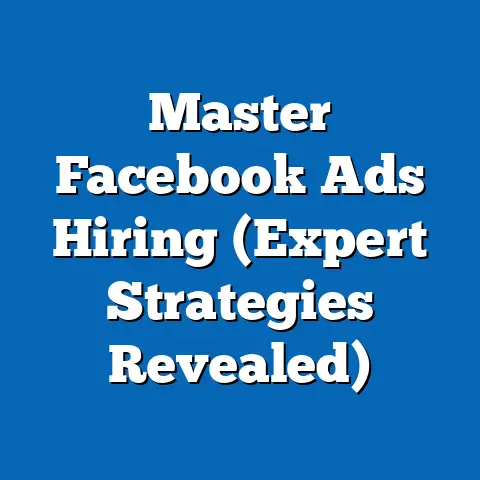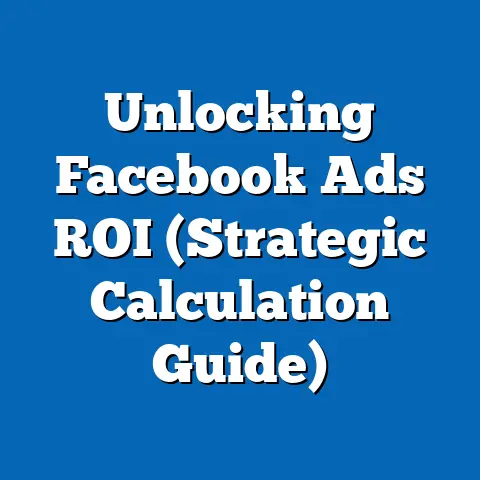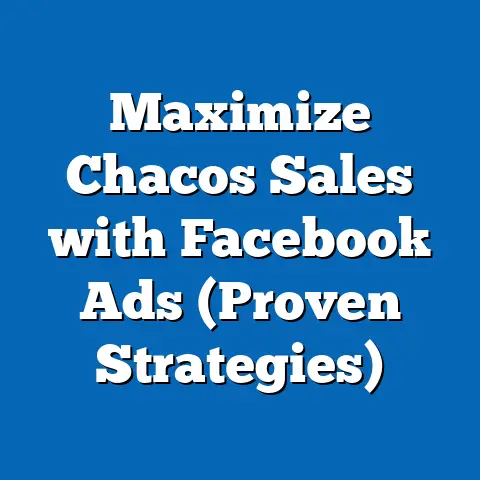Boost App’s Visibility with Facebook Ads (Expert Strategies)
Life moves fast, doesn’t it? Between work deadlines, family commitments, and trying to carve out a little “me” time, it feels like we’re all juggling a million things at once. In this whirlwind, apps have become our digital life rafts, simplifying tasks, boosting productivity, and connecting us to the world. But as app developers, you know the challenge: creating an amazing app is only half the battle. Getting it noticed in the crowded app marketplace? That’s a whole different ball game.
I’ve been there. Back when I launched my first productivity app, I thought the quality of the app would speak for itself. I was wrong. It languished in the app store, unseen and unloved. That’s when I dove headfirst into the world of Facebook Ads. And what I discovered was a powerful tool that, when used strategically, could catapult an app from obscurity to the screens of the people who need it most.
That’s where Facebook Ads come in. They’re not just about pretty pictures and catchy slogans; they’re a strategic weapon that can elevate your app’s visibility, drive user engagement, and ultimately, boost your success. In this guide, I’m going to share expert strategies – the same strategies I used to turn my struggling app into a thriving one – to help you effectively leverage Facebook Ads for app promotion. Let’s get started!
Understanding the Facebook Ads Ecosystem
Facebook isn’t just a social media platform; it’s a marketing powerhouse with billions of users. For app developers, it’s a goldmine. Think about it:
- Massive Reach: With over 2.9 billion monthly active users, Facebook offers unparalleled reach to potential app users.
- Granular Targeting: Facebook’s sophisticated targeting options allow you to pinpoint your ideal audience based on demographics, interests, behaviors, and even connections.
- Diverse Ad Formats: From eye-catching image ads to engaging video ads and interactive carousel ads, Facebook offers a variety of ad formats to showcase your app’s unique features.
But it’s not enough to just throw ads out there. You need to understand the landscape. I remember early on, I was just boosting posts, hoping for the best. It was like throwing spaghetti at the wall and hoping something stuck. The real power lies in understanding the different ad formats and how they can be used to highlight what your app does best.
Here’s a quick rundown of some popular ad formats:
- Image Ads: Simple, clean, and effective. Use high-quality images or graphics to showcase your app’s interface or key features.
- Video Ads: Capture attention with short, engaging videos that demonstrate your app’s functionality and benefits.
- Carousel Ads: Showcase multiple features or benefits of your app with interactive, scrollable cards.
- Collection Ads: Ideal for e-commerce apps, collection ads allow users to browse products directly from the ad.
Behind the scenes is the Facebook Ads Manager, your control center for all things advertising. It’s where you create campaigns, define your audience, set your budget, and track your results. While it might seem overwhelming at first, mastering the Ads Manager is crucial for running successful app promotion campaigns. I suggest taking the time to explore the interface and familiarize yourself with its various features. Facebook Blueprint offers a wealth of free courses and tutorials that can help you get started.
Key Takeaway: Facebook Ads offer immense potential for app marketing, but understanding the platform and its features is key to success.
Defining Your Target Audience
Imagine launching a fishing app targeted towards urban dwellers who have never held a rod. It wouldn’t work, right? That’s why defining your target audience is paramount. Effective advertising hinges on reaching the right people with the right message.
I learned this lesson the hard way. I initially cast a wide net, targeting everyone who owned a smartphone. My results were lackluster, to say the least. It wasn’t until I narrowed my focus and created detailed user personas that my campaigns started to take off.
Here are some methods to define your target audience:
- User Personas: Create fictional representations of your ideal users, including their demographics, interests, pain points, and motivations.
- Market Research: Conduct surveys, interviews, and focus groups to gather data on potential users and their needs.
- Competitor Analysis: Analyze your competitors’ target audience to identify potential overlaps and opportunities.
But it’s Facebook’s own tools that really shine. The Audience Insights tool is your secret weapon. It allows you to gather data on potential users based on their demographics, interests, behaviors, and connections on Facebook. This data can be invaluable for creating highly targeted ad campaigns.
For example, let’s say you have a fitness app. Using Audience Insights, you might discover that your ideal users are women aged 25-45 who are interested in yoga, healthy eating, and fitness trackers. You can then use this information to create ad campaigns that specifically target this audience.
Key Takeaway: Don’t guess your audience. Use data-driven insights to define your target audience and create highly targeted ad campaigns.
Crafting Compelling Ad Copy and Creative
You’ve got the right audience, now you need to grab their attention. Ad copy and visuals are the dynamic duo that can make or break your campaign.
Think of it this way: your ad is like a digital billboard. You have a few seconds to capture someone’s attention and convince them to take action. That’s why your ad copy needs to be concise, engaging, and relevant to your target audience.
Here are some tips for writing killer ad copy:
- Focus on Benefits, Not Features: Highlight how your app will solve a problem or improve their lives.
- Use Strong Headlines: Grab attention with a compelling headline that speaks to their needs.
- Include a Clear Call-to-Action: Tell them exactly what you want them to do (e.g., “Download Now,” “Learn More,” “Start Your Free Trial”).
Visuals are just as important. High-quality images and videos can showcase your app’s features, user interface, and overall value proposition. Here are some tips for creating eye-catching visuals:
- Use High-Quality Images and Videos: Avoid blurry or pixelated images.
- Showcase Your App in Action: Demonstrate how your app works and its key features.
- Use Bright Colors and Bold Graphics: Capture attention and stand out from the crowd.
But it’s not enough to just create a single ad and hope for the best. I’ve found that A/B testing is critical for optimizing your ad performance. A/B testing involves creating multiple versions of your ad – with different headlines, visuals, or calls-to-action – and then testing them against each other to see which performs best.
For example, you might test two different headlines:
- Headline A: “Simplify Your Life with Our Productivity App”
- Headline B: “Get More Done in Less Time with Our App”
By running these ads side-by-side, you can see which headline resonates best with your audience and use that information to optimize your campaigns.
Key Takeaway: Compelling ad copy and visuals are essential for capturing attention and driving action. Use A/B testing to optimize your ads and improve your results.
Setting Up Effective Campaign Objectives
Before you launch your Facebook Ad campaign, you need to define what you want to achieve. What’s the goal? More app installs? Increased user engagement? Driving traffic to your website?
Facebook Ads offers a variety of campaign objectives, each designed to help you achieve a specific outcome. Choosing the right objective is crucial for ensuring that your campaigns are aligned with your overall marketing goals.
Here are some common campaign objectives for app promotion:
- App Installs: Drive downloads of your app from the App Store or Google Play.
- Traffic: Drive traffic to your app’s website or landing page.
- Engagement: Increase user engagement with your app, such as app opens, in-app purchases, or content sharing.
I remember when I first started using Facebook Ads, I was so focused on getting app installs that I neglected other important objectives, like engagement. As a result, I saw a lot of downloads, but not a lot of long-term user retention.
That’s why it’s important to consider the entire marketing funnel when setting up your campaigns. For example, you might start with a traffic campaign to drive awareness of your app, then follow up with an app install campaign to drive downloads, and finally, run an engagement campaign to encourage users to use your app more frequently.
When setting up your campaign, you’ll also need to consider your budget and ad placement options. Facebook offers a variety of ad placement options, including Facebook Feed, Instagram Feed, Audience Network, and Messenger. Choosing the right placement options can help you reach your target audience more effectively.
Key Takeaway: Choose the right campaign objective based on your app’s goals and the stage of the marketing funnel. Consider your budget and ad placement options to maximize your results.
Budgeting and Bidding Strategies
How much should you spend on Facebook Ads? It’s the million-dollar question, isn’t it? There’s no one-size-fits-all answer, but understanding the basics of budgeting and bidding strategies can help you make informed decisions.
Facebook offers two main budget strategies:
- Daily Budget: Set a fixed amount that you’re willing to spend each day.
- Lifetime Budget: Set a total amount that you’re willing to spend over the entire duration of your campaign.
I typically recommend starting with a daily budget, especially when you’re first experimenting with Facebook Ads. This allows you to monitor your performance more closely and make adjustments as needed.
In addition to budgeting, you also need to understand Facebook’s bidding options. Facebook offers several bidding options, including:
- Cost Per Click (CPC): You pay each time someone clicks on your ad.
- Cost Per Mille (CPM): You pay for every 1,000 impressions your ad receives.
Choosing the right bidding strategy depends on your campaign objective and your target audience. For example, if you’re focused on driving traffic to your website, CPC bidding might be a good option. If you’re focused on brand awareness, CPM bidding might be more effective.
I’ve found that it’s often helpful to start with automatic bidding, which allows Facebook to automatically optimize your bids based on your campaign objective. As you gather more data, you can switch to manual bidding and set your own bids based on your performance.
Key Takeaway: Understand the basics of budgeting and bidding strategies to make informed decisions about your ad spend. Monitor your performance and adjust your budgets and bids based on your results.
Analyzing and Optimizing Campaign Performance
You’ve launched your campaign, now what? It’s time to track your results and optimize your performance.
Facebook Ads Manager provides a wealth of data on your campaign performance, including:
- Impressions: The number of times your ad was displayed.
- Clicks: The number of times people clicked on your ad.
- Click-Through Rate (CTR): The percentage of people who clicked on your ad after seeing it.
- Cost Per Click (CPC): The average cost you paid for each click.
- Conversions: The number of people who took the desired action after clicking on your ad (e.g., downloading your app).
- Cost Per Conversion (CPC): The average cost you paid for each conversion.
I like to use Facebook Analytics to gain deeper insights into user behavior. Facebook Analytics allows you to track user activity within your app, such as app opens, in-app purchases, and content sharing. This data can help you understand how users are interacting with your app and identify areas for improvement.
Based on your data, you can optimize your campaigns by:
- Adjusting Targeting: Refine your targeting to reach a more relevant audience.
- Refining Ad Creatives: Experiment with different headlines, visuals, and calls-to-action.
- Reallocating Budgets: Shift your budget to the campaigns that are performing best.
Key Takeaway: Track your results and optimize your performance based on data. Use Facebook Ads Manager and Facebook Analytics to gain insights into your campaign performance and user behavior.
Conclusion
Facebook Ads offer a powerful way to boost your app’s visibility in a competitive marketplace. By understanding the platform, defining your target audience, crafting compelling ads, setting up effective campaigns, and optimizing your performance, you can effectively reach your ideal users and drive app success.
Remember, it’s not about just throwing money at Facebook Ads and hoping for the best. It’s about taking a strategic approach, based on data and insights, and constantly iterating to improve your results.
I know it can seem daunting at first, but trust me, with the right approach, you can master Facebook Ads and unlock the full potential of your app.
So, what are you waiting for? It’s time to take action!
Call to Action:
I’d love to hear about your experiences with Facebook Ads. What strategies have worked for you? What challenges have you faced? Share your thoughts and questions in the comments below! Let’s learn and grow together. If you’re looking for more personalized guidance on app marketing strategies, feel free to reach out! I’m always happy to help.

